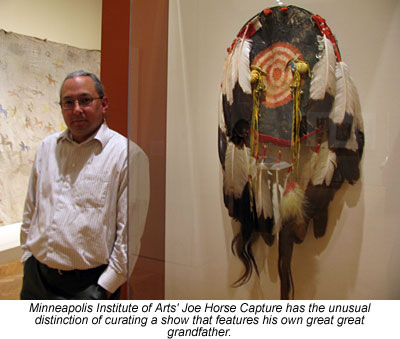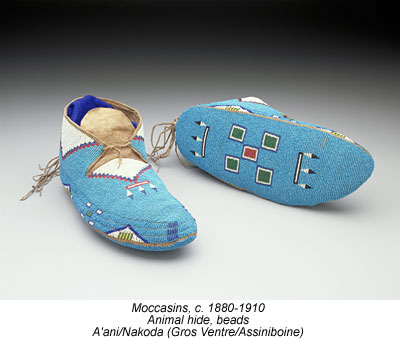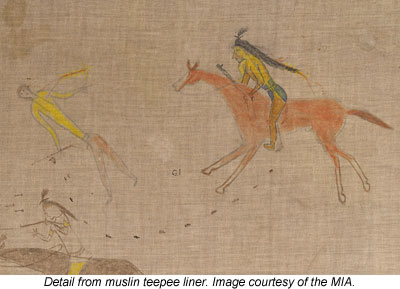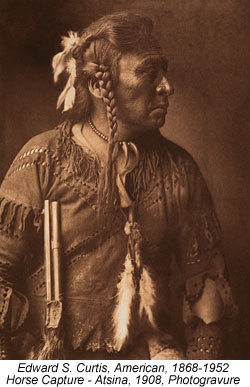 |
Canku Ota
|
 |
|
(Many Paths)
|
||
|
An Online Newsletter
Celebrating Native America
|
||
|
January 1, 2010 - Volume
8 Number 1
|
||
|
|
||
|
Art of the White
Clay People
|
||
|
by Marianne Combs -
Minnesota Public Radio
|
||
|
It is a way for me to connect with my ancestors - which happens rarely. And I'm really lucky to be in this position to make those connections. I stayed pretty objective throughout this entire exhibition, dealing with the objects my ancestors created...until the objects started showing up. This is the first time I've seen all of these objects together, out in the open. These used to be ours. And in a certain sense they're still ours - we don't have the title, but we have the intellectual property and the emotional connection. Horse Capture is working on creating a database of all the objects he found, which he plans to copy to cds and send back to the Fort Belknap Indian Reservation in North Central Montana. The tribe will be able to see the objects their ancestors created. Because many people don't ever get to see them - they're all gone, in museums. So part of this project here at the MIA is we're not only featuring this exhibition on the White Clay people, but we're also giving back to their community.
I have a real affection for moccasins because as native people were being forced to convert over to western clothing, that's the last thing they hung onto. You look at these historical photographs - they'll be wearing these suit coats, and pants and hats, but if you look at their feet, they're wearing moccasins. Covering one wall of the gallery is an 8' x 14' muslin teepee liner decorated with pictographs documenting the feats of warriors. In a rare turn of luck, Horse Capture was able to locate a key made for the pictographs created by the man who originally purchased the piece back in 1903. Scenes are labelled "F3" or "C2" - the letter corresponds to a person, while the number corresponds to a battle or deed. It's the scenes G1 and G2 that are of particular interest to Joe Horse Capture. This is where it gets a little bit kooky...these two are pictures of my great great grandfather Horse Capture. I've always seen him in sepia-toned photographs (taken by non-natives) and to now see him as his own people saw him, based on his accomplishments...it's nice to see those two things come together.
The images depict a warrior in yellow body paint charging on the enemy amidst a hail of bullets. It's quite different from the stillness in this portrait by Edward Curtis. Joe Horse Capture is a bit of a rarity in that he's a second-generation Native American museum curator. But he hopes more Native Americans will choose his career path. One way we can continue our tradition is to care for the objects our ancestors created. I like to think projects like this will encourage young Native American people to think about working in museums. Because in the past we've always had non-native anthropologists interpret our ways. And now as we're incorporating more native people in museums we're able to tell our own stories. I think this exhibiiton is a good example of that. "From Our Ancestors: Art of the White Clay People" runs through March 7 at the Minneapolis Institute of Arts. |
||
|
|
||
|
|
||
| Canku Ota is a free Newsletter celebrating Native America, its traditions and accomplishments . We do not provide subscriber or visitor names to anyone. Some articles presented in Canku Ota may contain copyright material. We have received appropriate permissions for republishing any articles. Material appearing here is distributed without profit or monetary gain to those who have expressed an interest. This is in accordance with Title 17 U.S.C. Section 107. | ||
|
Canku Ota is a copyright ©
2000, 2001, 2002, 2003, 2004, 2005, 2006, 2007, 2008, 2009, 2010
of Vicki Barry and Paul Barry.
|
||
 |
 |
|
|
The "Canku
Ota - A Newsletter Celebrating Native America" web site and
its design is the
|
||
|
Copyright ©
1999, 2000, 2001, 2002, 2003, 2004, 2005,
2006, 2007, 2008, 2009, 2010
of Paul C. Barry.
|
||
|
All Rights Reserved.
|
||
 Joe
Horse Capture is the Associate Curator of African, Oceanic and Native
American Art at the Minneapolis Institute of Arts. With a grant
from the Rockefeller Foundation, Horse Capture has been continuing
the work of his father to track down all of the artifacts of his
tribe - the A'aninin (the White Clay People) - now scattered to
museum collections around the world. Some of the results of his
search are now on display at the MIA. Horse Capture says it was
a moving experience.
Joe
Horse Capture is the Associate Curator of African, Oceanic and Native
American Art at the Minneapolis Institute of Arts. With a grant
from the Rockefeller Foundation, Horse Capture has been continuing
the work of his father to track down all of the artifacts of his
tribe - the A'aninin (the White Clay People) - now scattered to
museum collections around the world. Some of the results of his
search are now on display at the MIA. Horse Capture says it was
a moving experience. Because
the A'aninin are a very small tribe, Horse Capture says their art
was influenced by many other tribes they encountered, creating a
style that is unique to the region. The exhibition is divided into
two rooms - objects created by women, and objects created by men,
or for men. Much of the exhibition features moccasins with richly
colored beadwork.
Because
the A'aninin are a very small tribe, Horse Capture says their art
was influenced by many other tribes they encountered, creating a
style that is unique to the region. The exhibition is divided into
two rooms - objects created by women, and objects created by men,
or for men. Much of the exhibition features moccasins with richly
colored beadwork.
